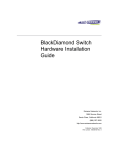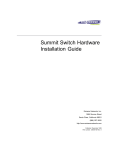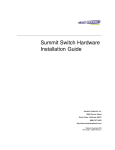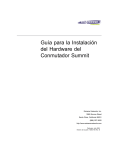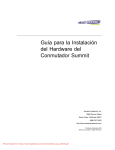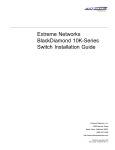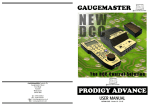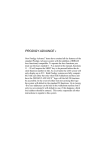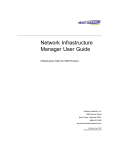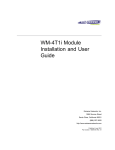Download Extreme Networks Alpine 3800 FM-32Ti Installation guide
Transcript
Alpine 3800 Series Switch Hardware Installation Guide Extreme Networks, Inc. 3585 Monroe Street Santa Clara, California 95051 (888) 257-3000 http://www.extremenetworks.com Published: March 2000 Part number: 100054-00 Rev. A ©2000 Extreme Networks, Inc. All rights reserved. Extreme Networks and BlackDiamond are registered trademarks of Extreme Networks, Inc. in the United States and certain other jurisdictions. ExtremeWare, ExtremeWare Vista, ExtremeWorks, ExtremeAssist, ExtremeAssist1, ExtremeAssist2, PartnerAssist, Extreme Standby Router Protocol, ESRP, SmartTraps, Alpine, Summit, Summit1, Summit4, Summit4/FX, Summit7i, Summit24, Summit48, Summit Virtual Chassis, SummitLink, SummitGbX, SummitRPS and the Extreme Networks logo are trademarks of Extreme Networks, Inc., which may be registered or pending registration in certain jurisdictions. The Extreme Turbodrive logo is a service mark of Extreme Networks, which may be registered or pending registration in certain jurisdictions. All other registered trademarks, trademarks and service marks are property of their respective owners. Specifications are subject to change without notice. ii Contents PREFACE Introduction xi Conventions xii Related Publications 1 xiii ALPINE 3800 SERIES SWITCH OVERVIEW Summary of Features 1-1 Port Connections 1-3 Media Types and Distances 1-4 Full-Duplex 1-5 Alpine 3800 Series Switch Components 1-6 Alpine 3804 Switch 1-6 Alpine 3808 Switch 1-7 Alpine 3800 Series Switch Power Supply 1-8 Power Supply LEDs 1-8 Switch Management Module 1-9 SMMi Memory 1-10 SMMi LEDs 1-10 Alpine 3800 Series Switch Fan Tray 1-11 I/O Module Cards 1-11 GM-4Ti Module 1-11 GM-4Xi Module 1-13 GM-4Si Module 1-14 FM-32Ti Module 1-15 FM-24Fi Module 1-16 iii I/O Module LEDs 1-16 Alpine 3804 Switch Rear View 1-17 Alpine 3808 Switch Rear View 1-18 2 INSTALLATION AND SETUP Following Safety Information 2-1 Determining the Switch Location 2-2 Installing the Alpine 3800 series switch 2-2 Installing the Alpine 3800 series switch components Installing the Power Supplies 2-6 Installing Module Cards 2-7 Powering On the System 2-9 Checking the Installation 2-9 Connecting Equipment to the Console Port 2-9 Logging In for the First Time 2-11 3 SERVICE AND 2-6 MAINTENANCE Following Safety Information 3-1 Removing and Replacing a Module Card 3-2 Removing and Replacing a Power Supply 3-3 Removing and Replacing an Alpine 3804 Power Supply 3-3 Removing and Replacing an Alpine 3808 Power Supply 3-5 Removing and Replacing the Fan Tray 3-7 Removing and Replacing the Alpine 3804 Fan Tray 3-7 Removing and Replacing the Alpine 3808 Fan Tray 3-9 Adding and Removing SODIMMs 3-11 Adding and Removing GBICs 3-12 A SAFETY INFORMATION Important Safety Information Power A-1 Power Cord A-2 Connections A-3 Lithium Battery A-3 iv A-1 B TECHNICAL SPECIFICATIONS INDEX v vi Figures 1-1 1-2 1-3 1-4 1-5 1-6 1-7 1-8 1-9 1-10 1-11 2-1 2-2 2-3 2-4 2-5 2-6 2-7 3-1 3-2 3-3 3-4 3-5 3-6 3-7 3-8 Alpine 3804 switch 1-6 Alpine 3808 Switch 1-7 Switch Management Module (SMMi) 1-9 SMMi SODIMM sockets 1-10 GM-4Ti module 1-12 GM-4Xi module 1-13 GM-4Si module 1-14 FM-32Ti module 1-15 FM-24Fi module 1-16 Alpine 3804 switch rear view 1-17 Alpine 3808 switch rear view 1-18 Rack-mount helper bracket 2-3 Alpine 3804 chassis mounted in rack 2-4 Alpine 3808 chassis mounted in rack 2-5 Power supply bays 2-6 SMMi with extended ejector/injector handles 2-8 Null-modem cable pinouts 2-10 PC-AT serial null-modem cable pinouts 2-11 Alpine 3804 power supply 3-4 Alpine 3808 power supply 3-5 Removing the Alpine 3804 fan tray 3-7 Alpine 3804 fan tray 3-8 Removing the fan tray 3-9 Alpine 3808 fan tray 3-10 Adding a SODIMM 3-11 GBIC connectors 3-12 vii viii Tables 1 2 1-1 1-2 1-3 1-4 1-5 1-6 2-1 Notice Icons xii Text Conventions xii Media Types and Distances 1-4 1000BASE-LX70 Specifications 1-5 1000BASE-SX and 1000BASE-LX Specifications Power Supply LEDs 1-8 SMMi LEDs 1-10 I/O Module LEDs 1-16 Console Connector Pinouts 2-10 1-5 ix x Preface This Preface provides an overview of this guide, describes guide conventions, and lists other publications that may be useful. INTRODUCTION This guide provides the required information to install the Alpine™ 3800 series switch. This guide is intended for use by network administrators who are responsible for installing and setting up network equipment. It assumes a basic working knowledge of: • Local Area Networks (LANs) • Ethernet concepts • Ethernet switching and bridging concepts • Routing concepts • Simple Network Management Protocol (SNMP) For information on configuring the Alpine 3800 series switch, refer to the ExtremeWare Software User Guide. If the information in the “Release Notes” shipped with your switch differs from the information in this guide, follow the “Release Notes.” ALPINE 3800 SERIES SWITCH HARDWARE INSTALLATION GUIDE XI PREFACE CONVENTIONS Table 1 and Table 2 list conventions used throughout this guide. Table 1: Notice Icons Icon Notice Type Alerts you to... Note Important features or instructions. Caution Risk of personal injury, system damage, or loss of data. Warning Risk of severe personal injury. Table 2: Text Conventions Convention Description Screen displays This typeface represents information as it appears on the screen, or command syntax. Screen displays bold This typeface represents commands that you type. The words “enter” and “type” When you see the word “enter” in this guide, you must type something, and then press the Return or Enter key. Do not press the Return or Enter key when an instruction simply says “type.” [Key] names Key names appear in text in one of two ways: ■ Referred to by their labels, such as “the Return key” or “the Escape key” ■ Written with brackets, such as [Return] or [Esc] If you must press two or more keys simultaneously, the key names are linked with a plus sign (+). Example: Press [Ctrl]+[Alt]+[Del]. Words in italicized type XII Italics emphasize a point or denote new terms at the place where they are defined in the text. ALPINE 3800 SERIES SWITCH HARDWARE INSTALLATION GUIDE RELATED PUBLICATIONS RELATED PUBLICATIONS The Alpine documentation set includes the following: • ExtremeWare Software User Guide • ExtremeWare Quick Reference Guide Documentation for Extreme Networks products is available on the World Wide Web at the following location: • http://www.extremenetworks.com/support/documentation.asp ALPINE 3800 SERIES SWITCH HARDWARE INSTALLATION GUIDE XIII PREFACE XIV ALPINE 3800 SERIES SWITCH HARDWARE INSTALLATION GUIDE 1 Alpine 3800 Series Switch Overview The Alpine 3800 series switch is a chassis-based, Ethernet service provisioning switch designed for edge and aggregation applications. The Alpine 3800 series switch is flexible and scalable, making it easy for you to meet the changing requirements of your network. The combination of BlackDiamond, Alpine, and Summit switches delivers a consistent end-to-end network solution that provides a nonblocking architecture, wire-speed switching, wire-speed IP routing, and policy-based Quality of Service (QoS). This chapter describes the following: • Alpine 3800 series switch features • Network configurations using the Alpine 3800 series switch • Alpine 3800 series switch components SUMMARY OF FEATURES The features of the Alpine 3800 series switch include the following: • A 5-slot or 9-slot chassis that can be populated with up to 4 or 8 input/output (I/O) modules and one Switch Management Module (SMMi) • I/O modules are hot-swappable, and include Gigabit Ethernet or 10/100 Mbps Ethernet ports • Redundant, load-sharing, hot-swappable power supplies • Field-replaceable, hot-swappable fan tray Alpine 3800 Series Switch Hardware Installation Guide 1-1 ALPINE 3800 SERIES SWITCH OVERVIEW • Up to 128 switched 10BASE-T/100BASE-TX Ethernet ports (model 3804), or up to 256 switched 10BASE-T/100BASE-TX Ethernet ports (model 3808) • Up to 96 switched 100BASE-FX Fast Ethernet ports (model 3804), or up to 192 switched 100BASE-FX Fast Ethernet ports (model 3808) • Up to 16 switched Gigabit Ethernet ports (model 3804), or up to 32 switched Gigabit Ethernet ports (model 3808) • Fully nonblocking operation — All ports transmit and receive packets at wire speed • Autonegotiation for half- or full-duplex operation on 10/100 Mbps ports • Load-sharing on multiple ports • Virtual local area networks (VLANs), including support for IEEE 802.1Q • Spanning Tree Protocol (STP) (IEEE 802.1D) with multiple STP domains • Policy-Based Quality of Service (QoS) • Wire-speed Internet Protocol (IP) routing • IP Multinetting • Dynamic Host Configuration Protocol/Bootstrap Protocol (DHCP/BOOTP) Relay • Routing Information Protocol (RIP) version 1 and RIP version 2 • Open Shortest Path First (OSPF) routing protocol • IPX routing, including RIP and Service Advertisement Protocol (SAP) • Wire-speed IP multicast routing support • Internet Group Multicast Protocol (IGMP) and IGMP snooping • Distance Vector Multicast Routing Protocol (DVMRP) • IGMP snooping to control IP multicast traffic • Console (RS-232) command-line interface (CLI) connection • Telnet CLI connection • ExtremeWare™ Vista™ Web-based management interface • Simple Network Management Protocol (SNMP) support • Dedicated 10BASE-T/100BASE-TX port for out-of-band management via CLI, ExtremeWare Vista, and/or SNMP 1-2 Alpine 3800 Series Switch Hardware Installation Guide SUMMARY OF FEATURES PORT CONNECTIONS Both Alpine 3800 series switches support the following I/O modules: • GM-4Ti module The GM-4Ti module has four Gigabit Ethernet ports, using standard RJ-45 connectors. The GM-4T module supports autonegotiation of 100BASE-TX/1000BASE-T. • GM-4Xi module The GM-4Xi module has four Gigabit Ethernet ports, using standard Gigabit Interface Connectors (GBICs). The GM-4Xi module supports 1000BASE-SX, 1000BASE-LX, and 1000BASE-LX70 GBIC modules. • GM-4Si module The GM-4S imodule has four Gigabit Ethernet ports, using standard MT-RJ connectors. The GM-4Si module supports 1000BASE-SX only. • FM-32Ti module The FM-32Ti module has 32 10/100 Mbps autonegotiating Ethernet ports, using standard RJ-45 connectors. The FM-32Ti module supports 10BASE-T and 100BASE-TX. • FM-24Fi module The FM-24Fi module has 24 100 Mbps Ethernet ports, using standard MT-RJ connectors. The FM-24Fi module supports 100BASE-FX in full-duplex mode only. Caution: Modules that use SX, LX, LX70, and FX interfaces contain Class 1 laser devices. Invisible laser radiation can occur when open. Avoid direct eye exposure to beam. Alpine 3800 Series Switch Hardware Installation Guide 1-3 ALPINE 3800 SERIES SWITCH OVERVIEW MEDIA TYPES AND DISTANCES Table 1-1 describes the media types and distances for the different types of Alpine 3800 series switch ports. Table 1-1: Media Types and Distances Standard Media Type Mhz/Km Rating Maximum Distance 1000BASE-SX 50/125 µm Multimode Fiber 400 500 Meters 50/125 µm Multimode Fiber 500 550 Meters 62.5/125 µm Multimode Fiber 160 220 Meters 62.5/125 µm Multimode Fiber 200 275 Meters 50/125 µm Multimode Fiber 400 550 Meters 50/125 µm Multimode Fiber 500 550 Meters 62.5/125 µm Multimode Fiber 500 550 Meters 1000BASE-LX 10u Single-mode Fiber 5,000 Meters 10u Single-mode Fiber* 10,000 Meters 1000BASE-LX70 10u Single-mode Fiber 70,000 Meters 100BASE-FX 50/125 µm Multimode Fiber (full-duplex operation) 2000 Meters 62.5/125 µm Multimode Fiber (full-duplex operation) 2000 Meters 1000BASE-T Category 5 and higher UTP Cable 100 Meters 100BASE-TX Category 5 and higher UTP Cable 100 Meters 10BASE-T Category 3 and higher UTP Cable 100 Meters *Extreme Networks proprietary. Connections between two Extreme Networks 1000BASE-LX interfaces can use a maximum distance of 10,000 meters. 1-4 Alpine 3800 Series Switch Hardware Installation Guide SUMMARY OF FEATURES Table 1-2 describes the specifications for the 1000BASE-LX70 interface. Table 1-2: 1000BASE-LX70 Specifications Parameter Minimum Typical Maximum Optical Output Power 0dBm 3dBm 5dBm* Center Wavelength 1540nm 1550nm 1560nm Transceiver Receiver Optical Input Power Sensitivity -20dBm Optical Input Power Maximum Operating Wavelength -3dBm 1200nm 1560nm *The transmitter output power level for the 1000BASE-LX70 is +5dBm. The maximum allowable receiver input power level is -3dBm. Therefore, there is a minimum of 8dB loss required for the link to operate without errors. This minimum required loss can be achieved using a fiber length of 32km (0.25dB/km provides 8dB loss), or by adding 10dB of fixed optical attenuator at the receiver end. Table 1-3 describes the specifications for the 1000BASE-SX and 1000BASE-LX interfaces. Table 1-3: 1000BASE-SX and 1000BASE-LX Specifications Parameter Minimum Maximum SX -9.5dBm 0dBm LX -11dBm -3dBm SX -17dBm 0dBm LX -19dBm -3dBm Tranceiver Receiver FULL-DUPLEX The Alpine 3800 series switch provides full-duplex support for all ports. Full-duplex allows frames to be transmitted and received simultaneously and, in effect, doubles the bandwidth available on a link. All ports on the Alpine 3800 series switch autonegotiate for half- or full-duplex operation. Gigabit Ethernet and 100BASE-FX ports operate in full-duplex mode, only. Alpine 3800 Series Switch Hardware Installation Guide 1-5 ALPINE 3800 SERIES SWITCH OVERVIEW ALPINE 3800 SERIES SWITCH COMPONENTS There are two models in the Alpine 3800 series: the Alpine 3804 switch, and the Alpine 3808 switch. ALPINE 3804 SWITCH The Alpine 3804 switch, shown in Figure 1-1, consists of the following components: • One 5-slot chassis with backplane • Four I/O module slots, labeled Slot 1 through Slot 4 • One SMM module slot • One or two power supplies (accessed from the rear of the unit) • One fan tray • One electromagnetic discharge (ESD) wrist strap receptacle ESD wrist strap connector Fan tray SMM module slot 1 2 3 4 1 2 3 4 I/O module slots 1 2 3 4 5 6 7 8 9 10 11 12 13 14 15 16 17 18 19 20 21 22 23 1 4 5 8 9 12 13 16 17 20 21 24 25 28 29 32 24 38_3804 Figure 1-1: Alpine 3804 switch 1-6 Alpine 3800 Series Switch Hardware Installation Guide ALPINE 3800 SERIES SWITCH COMPONENTS ALPINE 3808 SWITCH The Alpine 3808 switch, shown in Figure 1-2, consists of the following components: • One 9-slot chassis with backplane • Eight I/O module slots, labeled Slot 1 through Slot 8 • One SMM module slot • Two power supply slots • One fan tray • One electromagnetic discharge (ESD) wrist strap receptacle Blank for second power supply SERVICE 45012 WHEN INSTALLED IN 3808 THIS WAY UP Hz 50 60 A 13 6 Hz 50 60 V 100-120 200-240 V 100-120 200-240 SLIDE TO REMOVE Power supply ESD wrist strap connector A 13 6 WHEN INSTALLED IN 3804 THIS WAY UP DC OK DC OK Fan tray SMM module slot 1 2 3 4 1 2 3 4 1 2 3 4 1 2 3 4 I/O module slots 1 2 3 4 5 6 7 8 9 10 11 12 13 14 15 16 17 18 19 20 21 22 23 24 1 2 3 4 5 6 7 8 9 10 11 12 13 14 15 16 17 18 19 20 21 22 23 24 1 4 5 8 9 12 13 16 17 20 21 24 25 28 29 32 1 4 5 8 9 12 13 16 17 20 21 24 25 28 29 32 38_3808 Figure 1-2: Alpine 3808 Switch Alpine 3800 Series Switch Hardware Installation Guide 1-7 ALPINE 3800 SERIES SWITCH OVERVIEW ALPINE 3800 SERIES SWITCH POWER SUPPLY The Alpine 3800 series switch can have one or two AC or DC power supplies. The AC power supplies auto-sense for 110V and 220V power. The DC power supplies require -48 VDC input line voltage. When two power supplies are present, the power is load-shared between the supplies for enhanced longevity. AC and DC power supplies may be combined in the same chassis. Both AC and DC power supplies are hot-swappable. SNMP traps are sent for the following events: • AC power failure • Power supply failure • Power supply is removed POWER SUPPLY LEDS Table 1-4 describes the light emitting diode (LED) behavior on the power supply. Table 1-4: Power Supply LEDs LED Color Indicates D/C OK Green All DC outputs are operational Off One or more DC outputs have failed 1-8 Alpine 3800 Series Switch Hardware Installation Guide ALPINE 3800 SERIES SWITCH COMPONENTS SWITCH MANAGEMENT MODULE The Switch Management Module (SMMi) is responsible for upper-layer protocol processing and switch management functions. The SMMi can store two ExtremeWare software images (version 6.0 or greater) and two switch configurations. Figure 1-3 shows the SMMi. Module status LEDs Console port Modem port Module reset Management port PCMCIA slot 38_SMMi Figure 1-3: Switch Management Module (SMMi) The SMMi has the following out-of-band management ports: • Console port (used to connect a terminal and perform local management) • 10/100BASE-TX Ethernet port • Modem port (used to connect a modem for remote access to the CLI) • PCMCIA slot (not used for normal operation) Alpine 3800 Series Switch Hardware Installation Guide 1-9 ALPINE 3800 SERIES SWITCH OVERVIEW SMMI MEMORY The SMMi has two 144-pin SODIMM sockets, and ships with two 128MB SODRAM modules installed, as shown in Figure 1-4. Only SODIMMs supplied by Extreme Networks are supported in the SMMi. 38_SODMs Figure 1-4: SMMi SODIMM sockets For information on adding or removing SODIMMs, refer to Chapter 3. SMMI LEDS Table 1-5 describes the LED behavior on the SMMi. Table 1-5: SMMi LEDs LED Color Indicates DIAG Green (blinking) Power-on Self Test (POST) is running Off Normal operation Green (blinking) Normal Operation Yellow (blinking) Critical error, fan failure or over temperature Off Unit powered down PSUA Green PSU is OK PSUB Amber DC output failure Off PSU not present or not powered STATUS 1-10 Alpine 3800 Series Switch Hardware Installation Guide ALPINE 3800 SERIES SWITCH COMPONENTS ALPINE 3800 SERIES SWITCH FAN TRAY The fan tray for the Alpine 3804 contains 3 fans and the fan tray for the Alpine 3808 contains 5 fans. Fan trays for each model are accessed from the front of the chassis. The fan status is monitored by the software for fan failure conditions. All fan failures and over-temperature events trigger management alerts (for example, SNMP traps and SYSLOG messages). For more information on switch monitoring, refer to the ExtremeWare Software User Guide. I/O MODULE CARDS The Alpine 3800 series switch has five I/O modules, as follows: • GM-4Ti module • GM-4Xi module • GM-4Si module • FM-32Ti module • FM-24Fi module I/O modules can be inserted or removed at any time, without causing disruption of network services. No configuration information is stored on the I/O modules; all configuration information is stored on the SMMi. When the Alpine 3800 series switch is powered on, ExtremeWare generates a default configuration for any slots that are occupied with I/O modules. The default configuration allows the I/O module ports to participate in the VLAN named default. The default configuration for the I/O module is not preserved unless you explicitly save the information to nonvolatile RAM (NVRAM). You can use ExtremeWare to configure the I/O module. You can also pre-configure the parameters of a module that has not yet been inserted into the chassis. The pre-configured information is used once the module is inserted. You must select a module type for the slot before you can pre-configure the parameters. If you pre-configure a slot for a specific module type, and then insert a different type of module, the module reverts to its default configuration. GM-4TI MODULE The GM-4Ti module is shown in Figure 1-5. Alpine 3800 Series Switch Hardware Installation Guide 1-11 ALPINE 3800 SERIES SWITCH OVERVIEW Module status LED Port speed LEDs 100/1000 Mbps ports 1 2 3 4 Port status LEDs 38_GM4T Figure 1-5: GM-4Ti module The GM-4Ti module has four Gigabit Ethernet ports. All Gigabit Ethernet ports on this module use standard RJ-45 connectors and autonegotiate for 100BASE-TX or 1000BASE-T. The default configuration of the GM-4Ti modules is as follows: • All ports are added to the default VLAN as untagged. • All ports inherit the properties of the default VLAN (for example, protocol type, VLANid, and so on). • All ports are in autonegotiation mode. For supported media types and distances, refer to Table 1-1. 1-12 Alpine 3800 Series Switch Hardware Installation Guide ALPINE 3800 SERIES SWITCH COMPONENTS GM-4XI MODULE The GM-4Xi module is shown in Figure 1-6. Module status LED Gigabit Ethernet ports 1 2 3 4 Port status LEDs 38_GM4X Figure 1-6: GM-4Xi module The GM-4Xi module has four GBIC-based Gigabit Ethernet ports. All Gigabit Ethernet ports on this module use standard GBIC connectors and support 1000BASE-SX, 1000BASE-LX, and 1000BASE-LX70. The default configuration of the GM-4Xi module is as follows: • All ports are added to the default VLAN as untagged. • All ports inherit the properties of the default VLAN (for example, protocol type, VLANid, and so on). • All ports are in autonegotiation mode. For supported media types and distances, refer to Table 1-1. GBICs for the GM-4Xi module are sold separately. Alpine 3800 Series Switch Hardware Installation Guide 1-13 ALPINE 3800 SERIES SWITCH OVERVIEW GM-4SI MODULE The GM-4Si module is shown in Figure 1-7. Module status LED 1000 Mbps ports 1 2 3 4 Port status LEDs 38_GM4S Figure 1-7: GM-4Si module The GM-4Si module has four standard MT-RJ connectors. The GM-4Si module supports 1000BASE-SX. The default configuration of the GM-4Si module is as follows: • All ports are added to the default VLAN as untagged. • All ports inherit the properties of the default VLAN (for example, protocol type, VLANid, and so on). • All ports are in autonegotiation mode. For supported media types and distances, refer to Table 1-1. 1-14 Alpine 3800 Series Switch Hardware Installation Guide ALPINE 3800 SERIES SWITCH COMPONENTS FM-32TI MODULE The FM-32Ti module is shown in Figure 1-8. Module status LED 1 4 5 8 9 12 13 16 17 20 21 24 25 28 29 32 Port status LEDs 10/100 Mbps ports 38_FM32T Figure 1-8: FM-32Ti module The FM-32Ti module has 32 autosensing 10BASE-T/100BASE-TX ports. All ports use standard RJ-45 connectors. The default configuration of the FM-32Ti module is as follows: • All ports are added to the default VLAN as untagged. • All ports inherit the properties of the default VLAN (protocol type, VLANid, and so on). • All ports are in autonegotiation mode allowing 10 Mbps or 100 Mbps, full duplex, or half-duplex operation. Alpine 3800 Series Switch Hardware Installation Guide 1-15 ALPINE 3800 SERIES SWITCH OVERVIEW FM-24FI MODULE The FM-24F module is shown in Figure 1-9. 1 2 3 4 5 6 7 8 9 10 Module status LED 11 12 13 14 15 16 100 Mbps ports with status LEDs 17 18 19 20 21 22 23 24 38_FM24F Figure 1-9: FM-24Fi module The FM-24Fi module has 24 100BASE-FX ports. All FM-24Fi ports use standard MT-RJ connectors. The default configuration of the FM-24Fi module is as follows: • All ports are added to the default VLAN as untagged. • All ports inherit the properties of the default VLAN (protocol type, VLANid, and so on). • All ports are in 100 Mbps, full-duplex mode. Half-duplex mode is not supported. I/O MODULE LEDS Table 1-6 describes the LED behavior on the I/O modules. Table 1-6: I/O Module LEDs LED Color Indicates Status Green solid Normal operation Amber solid Disabled Port x Green Link up (except FM-24F) Flashing Green Disabled Amber Packet activity Off Link down Port x Green Link up (FM24-F only) Flashing Green Packet activity Off 1-16 Link down Alpine 3800 Series Switch Hardware Installation Guide ALPINE 3804 SWITCH REAR VIEW ALPINE 3804 SWITCH REAR VIEW Figure 1-10 shows the rear view of the Alpine 3804 switch. Blank for second power supply DC OK DC OK WHEN INSTALLED IN 3804 THIS WAY UP Hz 50 60 A 13 6 Hz 50 60 V 100-120 200-240 V 100-120 200-240 Power supply A 13 6 SLIDE TO REMOVE WHEN INSTALLED IN 3808 THIS WAY UP SERVICE 45012 38_rear4 Figure 1-10: Alpine 3804 switch rear view The rear view of the Alpine 3804 switch provides the following: • Access to the power supply • The chassis serial number • The device Ethernet MAC address • Safety information Alpine 3800 Series Switch Hardware Installation Guide 1-17 ALPINE 3800 SERIES SWITCH OVERVIEW ALPINE 3808 SWITCH REAR VIEW Figure 1-11 shows the rear view of the Alpine 3808 switch. 38_rear8 Figure 1-11: Alpine 3808 switch rear view 1-18 Alpine 3800 Series Switch Hardware Installation Guide ALPINE 3808 SWITCH REAR VIEW The rear view of the Alpine 3808 switch provides the following: • The chassis serial number • The device Ethernet MAC address • Safety information Alpine 3800 Series Switch Hardware Installation Guide 1-19 ALPINE 3800 SERIES SWITCH OVERVIEW 1-20 Alpine 3800 Series Switch Hardware Installation Guide 2 Installation and Setup This chapter describes the following: • How to decide where to install the Alpine 3800 series switch • How to install the chassis in a rack • How to install the power supply • How to install modules in the chassis • How to connect equipment to the console port • How to check the installation using the Power On Self-Test (POST) Caution: Use of controls or adjustments of performance or procedures other than those specified herein may result in hazardous radiation exposure. FOLLOWING SAFETY INFORMATION All service to Alpine 3800 series switch modules, fan tray, and power supplies should be performed by trained service personnel only. Caution: Before installing or removing any components of the switch, or before carrying out any maintenance procedures, you must read the safety information provided in Appendix A of this guide. ALPINE 3800 SERIES SWITCH HARDWARE INSTALLATION GUIDE 2-1 INSTALLATION AND SETUP DETERMINING THE SWITCH LOCATION The Alpine 3800 series switch is suited for use in a wiring closet or equipment room, where it can be mounted in a standard 19-inch equipment rack. Mounting brackets are integrated with the chassis. When deciding where to install the Alpine 3800 series switch, ensure the following: • The switch is accessible and cables can be connected easily. • Water or moisture cannot enter the chassis. • Air-flow around the unit and through the vents at the sides of the chassis is not restricted. A minimum of 3 inches is required (5 inches recommended) for clearance. • Temperature operating limits of 0° to 40° C are not exceeded. INSTALLING THE ALPINE 3800 SERIES SWITCH The Alpine 3800 series switch fits in standard 19-inch racks. The Alpine 3800 series switch chassis is shipped empty; you must install the power supply and modules after rack-mounting the empty chassis. Warning: Rack-mount the chassis before installing any Alpine 3800 series switch components. To install the Alpine 3800 series switch in a standard 19-inch rack, follow these steps: 1 Mount the helper bracket in the rack using four appropriate rack-mounting screws, as shown in Figure 2-1. 2-2 ALPINE 3800 SERIES SWITCH HARDWARE INSTALLATION GUIDE INSTALLING THE ALPINE 3800 SERIES SWITCH BDbrackt Figure 2-1: Rack-mount helper bracket 2 Insert the empty chassis into the 19-inch rack and place it on the helper bracket. 3 Secure the empty chassis with four or eight suitable screws, depending on model, as shown in Figure 2-2 and Figure 2-3. ALPINE 3800 SERIES SWITCH HARDWARE INSTALLATION GUIDE 2-3 INSTALLATION AND SETUP 38_rack4 Figure 2-2: Alpine 3804 chassis mounted in rack 2-4 ALPINE 3800 SERIES SWITCH HARDWARE INSTALLATION GUIDE INSTALLING THE ALPINE 3800 SERIES SWITCH 38_rack8 Figure 2-3: Alpine 3808 chassis mounted in rack 4 Once the chassis is secured, remove the helper bracket. ALPINE 3800 SERIES SWITCH HARDWARE INSTALLATION GUIDE 2-5 INSTALLATION AND SETUP INSTALLING THE COMPONENTS ALPINE 3800 SERIES SWITCH Warning: Rack-mount the chassis before installing any Alpine 3800 series switch components. INSTALLING THE POWER SUPPLIES To install the Alpine 3800 series switch power supplies into the mounted chassis, follow these steps: 1 Install the first power supply in an empty power supply bay. a Ensure that the power supply is right side up using the text on the front of the power supply, and that the ejector/injector lever is open, as shown in Figure 2-4. Ejector/injector lever SERVICE 45012 WHEN INSTALLED IN 3808 THIS WAY UP Hz 50 60 A 13 6 Hz 50 60 V 100-120 200-240 V 100-120 200-240 SLIDE TO REMOVE ESD wrist strap connector A 13 6 WHEN INSTALLED IN 3804 THIS WAY UP DC OK DC OK 38_pwrx8 Figure 2-4: Power supply bays 2-6 ALPINE 3800 SERIES SWITCH HARDWARE INSTALLATION GUIDE INSTALLING THE ALPINE 3800 SERIES SWITCH COMPONENTS Caution: Support the power supply from the bottom, while holding the central handle on the front of the power supply unit. b Use the centrally mounted handle to slide the power supply into the bay. Use the ejector/injector lever to engage/disengage the power supply connectors during the last inch of insertion into the chassis. c Secure the power supply by tightening the screw on the ejector/injector lever using a #2 Phillips-head screwdriver. d Slide the locking latch covering the AC power connector to the right or left to uncover the power connector. Caution: Be careful not to slam the power supply into the backplane. The power supply cannot be installed if an AC power cord is plugged in. Damage to the chassis and power supply may result if an attempt is made to install a power supply with an AC power cord connected. 2 To install a second power supply, remove the blank plate from the empty power supply bay using a #1 Phillips-head screwdriver. 3 Install the second power supply, by repeating the procedure described in Step 1. INSTALLING MODULE CARDS Prior to installing module cards into the Alpine 3804/3808 chassis, put on the ESD wrist strap that is provided with the chassis, and connect the metal end to the ground receptacle located on the top-right corner of the switch front panel. Leave the ESD strap permanently connected to the chassis, so that it is always available when you need to handle ESD-sensitive components. ALPINE 3800 SERIES SWITCH HARDWARE INSTALLATION GUIDE 2-7 INSTALLATION AND SETUP To install the SMMi follow these steps: 1 Ensure that the SMMi is right side up (printed circuit board, or PCB, on top) and the ejector/injector handles are extended, as shown in Figure 2-5. 38_clips Figure 2-5: SMMi with extended ejector/injector handles 2 Slide the SMMi into the appropriate slot of the chassis, until it is fully seated in the backplane. Use the metal front panel, not the PCB, to guide the SMMi into the chassis. When the SMMi is fully seated in the chassis, the ejector/injector handles will begin to close. Caution: The SMMi can be installed in the top slot only. The SMMi does not fit in any other chassis slots. 3 To secure the SMMi in the chassis, close the ejector/injector handles by pushing on them toward the center of the module card, and tighten the screws using a #2 Phillips-head screwdriver. To install the I/O module(s), follow these steps: 1 Ensure that the I/O module is right side up, and the ejector/injector levers are extended. 2 Slide the I/O module into the appropriate slot of the chassis, until it is fully seated in the backplane. Caution: The I/O module can only be installed in the slots labeled Slot 1 through Slot 4 on the Alpine 3804, or Slot 1 through Slot 8 on the Alpine 3808. Forceful insertion can damage the I/O module. When the I/O module is fully seated in the chassis, the ejector/injector levers will begin to close. 2-8 ALPINE 3800 SERIES SWITCH HARDWARE INSTALLATION GUIDE POWERING ON THE SYSTEM 3 To secure the module in the chassis, close the ejector/injector levers by pushing on them toward the center of the module card, and tighten the screws using a #2 Phillips-head screwdriver. 4 Repeat this procedure for the additional I/O modules, if applicable. POWERING ON THE SYSTEM To turn on power to the system, connect the AC power cable to the power supply and then to the wall outlet. If you have installed two power supplies, connect both power cables. CHECKING THE INSTALLATION After turning on power to the Alpine 3800 series switch, the SMMi performs a power-on self test (POST). The LED labeled “DIAG” on the SMMi blinks green during the POST. Once the SMMi is operational, each I/O module performs a POST. For more information on the LEDs, refer to Chapter 1. CONNECTING EQUIPMENT TO THE CONSOLE PORT Connection to the console port is used for direct local management. The console port settings are configured as follows: • Baud rate — 9600 • Data bits — 8 • Stop bit — 1 • Parity — None • Flow control — XON/XOFF The terminal connected to the console port on the SMMi must be configured with the same settings. This procedure is described in the documentation supplied with the terminal. ALPINE 3800 SERIES SWITCH HARDWARE INSTALLATION GUIDE 2-9 INSTALLATION AND SETUP Appropriate cables are available from your local supplier. To make your own cables, pinouts for a DB-9 male console connector are described in Table 2-1. Table 2-1: Console Connector Pinouts Function Pin Number Direction DCD (data carrier detect) 1 In RXD (receive data) 2 In TXD (transmit data) 3 Out DTR (data terminal ready) 4 Out GND (ground) 5 - DSR (data set ready) 6 In RTS (request to send) 7 Out CTS (clear to send 8 In Figure 2-6 shows the pinouts for a 9-pin to 25-pin (RS-232) null-modem cable. Alpine PC-AT Serial Port Cable connector: 9-pin female Cable connector: 9-pin female Screen Shell DTR 4 TxD 3 RxD 2 CTS 8 Ground 5 DSR 6 RTS 7 DCD 1 Shell Screen DCD 1 RxD 2 TxD 3 DTR 4 Ground 5 DSR 6 RTS 7 CTS 8 38_9pin Figure 2-6: Null-modem cable pinouts 2-10 ALPINE 3800 SERIES SWITCH HARDWARE INSTALLATION GUIDE LOGGING IN FOR THE FIRST TIME Figure 2-7 shows the pinouts for a 9-pin to 9-pin (PC-AT) null-modem serial cable. Alpine PC-AT Serial Port Cable connector: 9-pin female Cable connector: 9-pin female Screen Shell DTR 4 TxD 3 RxD 2 CTS 8 Ground 5 DSR 6 RTS 7 DCD 1 Shell Screen DCD 1 RxD 2 TxD 3 DTR 4 Ground 5 DSR 6 RTS 7 CTS 8 38_9pin Figure 2-7: PC-AT serial null-modem cable pinouts LOGGING IN FOR THE FIRST TIME After the Alpine 3800 series switch has completed the POST, it is operational. Once operational, you can log in to the switch and configure an IP address for the default VLAN (named default). To manually configure the IP settings, perform the following steps: 1 Connect a terminal or workstation running terminal-emulation software to the SMMi console port. 2 At your terminal, press [Return] one or more times until you see the login prompt. 3 At the login prompt, enter the default user name admin to log on with administrator privileges. For example: login: admin Administrator capabilities allow you to access all switch functions. For more information on switch security, refer to the ExtremeWare Software User Guide. ALPINE 3800 SERIES SWITCH HARDWARE INSTALLATION GUIDE 2-11 INSTALLATION AND SETUP 4 At the password prompt, press [Return]. The default name, admin, has no password assigned. When you have successfully logged on to the system, the command-line prompt displays the system name (for example, Alpine3800>) in its prompt. 5 Assign an IP address and subnetwork mask for VLAN default by typing config vlan default ipaddress 123.45.67.8 255.255.255.0 Your changes take effect immediately. 6 Save your configuration changes so that they will be in effect after the next system reboot, by typing save The configuration is saved to the configuration database of the SMMi modules. For more information on saving configuration changes, refer to the ExtremeWare Software User Guide. 7 When you are finished using the facility, log out by typing logout 2-12 ALPINE 3800 SERIES SWITCH HARDWARE INSTALLATION GUIDE 3 Service and Maintenance This chapter describes the following: • How to remove and replace a module card • How to remove and replace a power supply • How to remove and replace the fan tray • How to add and remove SODIMMs on the SMMi • How to add and remove a GBIC Caution: Use of controls or adjustments of performance or procedures other than those specified herein may result in hazardous radiation exposure. FOLLOWING SAFETY INFORMATION All service to Alpine 3800 series switch modules, fan tray, and power supplies should be performed by trained service personnel, only. Caution: Before installing or removing any components of the system, or before carrying out any maintenance procedures, you must read the safety information provided in Appendix A of this guide. ALPINE 3800 SERIES SWITCH HARDWARE INSTALLATION GUIDE 3-1 SERVICE AND MAINTENANCE REMOVING AND REPLACING A MODULE CARD All Alpine 3800 series switch module cards (SMMi modules and I/O modules) are hot-swappable. You do not need to power off the system to remove or insert a module card. To remove and replace a module card, follow these steps: 1 Prior to installing module cards into the Alpine 3804 or Alpine 3808 chassis, put on the ESD wrist strap that is provided with the chassis, and connect the metal end to the ground receptacle located on the top-right corner of the Alpine 3800 front panel. 2 Loosen the module card by unscrewing the screws using a #2 Phillips-head screwdriver. 3 Rotate the ejector/injector levers to disengage the module card from the backplane. 4 Slide the module card out of the chassis. 5 Slide the new module card into the appropriate slot of the chassis (SMMi modules into the orange slot, I/O modules into Slots 1 through 4 on the Alpine 3804, or Slots 1 through 8 on the Alpine 3808), until it is fully seated in the backplane. 6 When the module is fully seated in the chassis, the ejector/injector levers will begin to close. 7 To secure the module in the chassis, close the ejector/injector levers by pushing on them toward the center of the module card, and tighten the screws using a #2 Phillips-head screwdriver. Caution: The I/O module can only be installed in the slots labeled Slot 1 through Slot 4 on the Alpine 3804, or Slot 1 through Slot 8 on the Alpine 3808. Forceful insertion can damage the I/O module. Caution: Ensure that the sheet metal of the module, and not the PCB board, engages the card cage runners. 3-2 ALPINE 3800 SERIES SWITCH HARDWARE INSTALLATION GUIDE REMOVING REMOVING AND REPLACING A AND REPLACING A POWER SUPPLY POWER SUPPLY Alpine 3800 series switch power supplies are hot-swappable. You can add a second power supply without powering off the chassis. If you have two power supplies installed, you can remove one of them without powering off the chassis. The power supplies on the Alpine 3804 switch are inserted into the lower rear of the chassis. The power supplies on the Alpine 3808 switch are inserted into the front of the chassis. REMOVING AND REPLACING AN ALPINE 3804 POWER SUPPLY To remove and replace a power supply on the Alpine 3804 switch, follow these steps: 1 Locate the power supply on the lower rear of the chassis. 2 Remove the AC power cord from the power supply. 3 Slide the locking latch on the power supply so that it covers the AC power connector. 4 Unscrew the screw on the ejector/injector lever using a #2 Phillips-head screwdriver. 5 Pull the ejector/injector lever towards you while holding on to the central handle to steady the power supply. 6 Supporting it with one hand, slide the power supply out of the chassis. The power supply is shown in Figure 3-1. ALPINE 3800 SERIES SWITCH HARDWARE INSTALLATION GUIDE 3-3 SERVICE AND MAINTENANCE DC OK DC OK WHEN INSTALLED IN 3804 THIS WAY UP A 13 6 SERVICE Hz 50 60 WHEN INSTALLED IN 3808 THIS WAY UP Hz 50 60 V 100-120 200-240 V 100-120 200-240 A 13 6 SLIDE TO REMOVE 45012 38_pwr Figure 3-1: Alpine 3804 power supply Caution: Ensure the latch covers the AC power connector. The power supply cannot be removed or installed unless the connector is covered. 7 Make sure that the replacement power supply is right-side up as described by the text on the front of the power supply, that the ejector/injector lever is open, and that the safety latch covers the AC power connector. 8 Use the centrally mounted handle to slide the power supply into the bay. Use the ejector/injector lever to engage/disengage the power supply connectors during the last inch of insertion into the chassis. Caution: Do not slam the power supply into the backplane. This will cause damage and possibly require the return of the chassis. 9 Secure the power supply by tightening the screw on the ejector/injector lever using a #2 Phillips-head screwdriver. 10 Slide the locking latch covering the AC power connector to the left until it locks into the chassis. 3-4 ALPINE 3800 SERIES SWITCH HARDWARE INSTALLATION GUIDE REMOVING REMOVING AND REPLACING AN AND REPLACING A POWER SUPPLY ALPINE 3808 POWER SUPPLY To remove and replace a power supply on the Alpine 3808 switch, follow these steps: 1 Locate the power supply on the front of the chassis. 2 Remove the AC power cord from the power supply. 3 Slide the locking latch on the power supply so that it covers the AC power connector. 4 Unscrew the screw on the ejector/injector lever using a #2 Phillips-head screwdriver. 5 Pull the ejector/injector lever towards you while holding on to the central handle to steady the power supply. 6 Supporting it with one hand, slide the power supply out of the chassis. The power supply is shown in Figure 3-2. Ejector/injector lever SERVICE 45012 WHEN INSTALLED IN 3808 THIS WAY UP Hz 50 60 A 13 6 Hz 50 60 V 100-120 200-240 V 100-120 200-240 SLIDE TO REMOVE ESD wrist strap connector A 13 6 WHEN INSTALLED IN 3804 THIS WAY UP DC OK DC OK 38_pwrx8 Figure 3-2: Alpine 3808 power supply ALPINE 3800 SERIES SWITCH HARDWARE INSTALLATION GUIDE 3-5 SERVICE AND MAINTENANCE Caution: Ensure the latch covers the AC power connector. The power supply cannot be removed or installed unless the connector is covered. 7 Make sure that the replacement power supply is right-side up as described by the text on the front of the power supply, that the ejector/injector lever is open, and that the safety latch covers the AC power connector. 8 Use the centrally mounted handle to slide the power supply into the bay. Use the ejector/injector lever to engage/disengage the power supply connectors during the last inch of insertion into the chassis. Caution: Do not slam the power supply into the backplane. This will cause damage and possibly require the return of the chassis. 9 Secure the power supply by tightening the screw on the ejector/injector lever using a #2 Phillips-head screwdriver. 10 Slide the locking latch covering the AC power connector to the right until it locks into the chassis. 3-6 ALPINE 3800 SERIES SWITCH HARDWARE INSTALLATION GUIDE REMOVING REMOVING AND REPLACING THE AND REPLACING THE FAN TRAY FAN TRAY The Alpine 3800 fan tray is hot-swappable. You do not need to turn off power to the Alpine 3800 switch to replace the fan tray. You can access the fan tray from the front of the Alpine 3800 chassis. REMOVING AND REPLACING THE ALPINE 3804 FAN TRAY To remove and replace the fan tray in the Alpine 3804 switch, follow these steps: 1 Unscrew the screw securing the fan tray to the chassis, as shown in Figure 3-3. Finger grip Turn screw head clockwise to lock & counter-clockwise to unlock fan tray Finger grip 38_fan4 Figure 3-3: Removing the Alpine 3804 fan tray 2 Pull the fan tray straight forward out of the chassis approximately 1-inch, as shown in Figure 3-4; this step disconnects the power, causing the fans to stop. ALPINE 3800 SERIES SWITCH HARDWARE INSTALLATION GUIDE 3-7 SERVICE AND MAINTENANCE 38_fanx4 Figure 3-4: Alpine 3804 fan tray 3 Allow the fan blades to stop spinning before removing the fan tray completely. Warning: Avoid personal injury. Keep hands away from rotating fan blades. 4 Insert the new fan tray into the bay. 5 Secure the fan tray by turning the screw clockwise until it becomes tight. 3-8 ALPINE 3800 SERIES SWITCH HARDWARE INSTALLATION GUIDE REMOVING REMOVING AND REPLACING THE AND REPLACING THE FAN TRAY ALPINE 3808 FAN TRAY To remove and replace the fan tray in the Alpine 3808 switch, follow these steps: 1 Unscrew the two screws securing the fan tray to the chassis, as shown in Figure 3-5. Finger grip Turn screw heads clockwise to lock & counter-clockwise to unlock fan tray Finger grip 38_fan8 Figure 3-5: Removing the fan tray 2 Pull the fan tray straight forward out of the chassis approximately 1-inch, as shown in Figure 3-6; this step disconnects the power, causing the fans to stop. ALPINE 3800 SERIES SWITCH HARDWARE INSTALLATION GUIDE 3-9 SERVICE AND MAINTENANCE E ST AL L N H z 50 60 A 13 6 10 V 200-1 0-220 40 H z 50 60 10 V 200-1 0-220 40 45 01 IN HE W A 13 6 SLI DE 2 TO RE M O VE 38_fanx8 Figure 3-6: Alpine 3808 fan tray 3 Allow the fan blades to stop spinning before removing the fan tray completely. Warning: Avoid personal injury. Keep hands away from rotating fan blades. 4 Insert the new fan tray into the bay. 5 Secure the fan tray by turning the screws clockwise until they become tight. 3-10 ALPINE 3800 SERIES SWITCH HARDWARE INSTALLATION GUIDE ADDING ADDING AND AND REMOVING SODIMMS REMOVING SODIMMS To add a SODIMM to the SMMi, follow these steps: 1 Prior to removing or installing SODIMMs on the SMMi, put on the ESD wrist strap that is provided with the chassis, and connect the metal end to the ground receptacle located on the top-right corner of the Alpine 3800 switch front panel. 2 Locate the SODIMM sockets on the SMMi. 3 Position the SODIMM in the socket by ensuring that the gold fingers of the SODIMM slip into the connector and the keying notches align. 4 Secure the SODIMM by pressing down firmly until the SODIMM is locked into the socket and the ejector locks rotate into position, as shown in Figure 3-7. 38_SODM Figure 3-7: Adding a SODIMM To remove a SODIMM, follow these steps: 1 Prior to removing or installing SODIMMs on the SMMi, put on the ESD wrist strap that is provided with the chassis, and connect the metal end to the ground receptacle located on the top-right corner of the Alpine 3800 switch front panel. 2 Disengage the SODIMM by pulling out on the ejector locks located on either side of the SODIMM. 3 Rotate the SODIMM out of the socket. ALPINE 3800 SERIES SWITCH HARDWARE INSTALLATION GUIDE 3-11 SERVICE AND MAINTENANCE ADDING AND REMOVING GBICS GBICs can be added and removed from the Alpine 3800 series switch without powering off the system. The two types of GBIC connectors are shown in Figure 3-8. Module A Module B EW_GBIC Figure 3-8: GBIC connectors GBICs are a Class 1 laser device. Use only Extreme-approved devices. To remove the GBIC connector labeled “Module A,” lift up on the front handle and pull the GBIC out of the slot. To remove the GBIC connector labeled “Module B,” gently squeeze the sides to release it, and pull the GBIC out of the slot. Ensure that the SC fiber-optic connector is removed from the GBIC prior to removing the GBIC from the I/O module. Caution: Invisible laser radiation can occur when open. Avoid direct eye exposure to beam. To insert a GBIC connector, follow these steps: 1 Holding the GBIC by its sides, insert the GBIC into the slot on the I/O module. 2 Slide the GBIC as far back into the slot as possible, until you hear it click. 3 If the GBIC has a handle, push down on the handle to secure the GBIC in the slot. 3-12 ALPINE 3800 SERIES SWITCH HARDWARE INSTALLATION GUIDE A Safety Information IMPORTANT SAFETY INFORMATION Warning: Read the following safety information thoroughly before installing the Alpine 3800 switch. Failure to follow this safety information can lead to personal injury or damage to the equipment. • Installation, maintenance, removal of parts, and removal of the unit and components must be done by qualified service personnel only. Service personnel are persons having appropriate technical training and experience necessary to be aware of the hazards to which they are exposed in performing a task and of measures to minimize the danger to themselves or other persons. • Install the unit only in a temperature- and humidity-controlled indoor area free or airborne materials that may conduct electricity. Too much humidity may cause a fire. Too much dryness may produce electrical shock and fire. POWER This unit has two power inputs. • Disconnect power before removing the back panel of the unit. • The unit must be grounded. • The unit must be connected to a grounded outlet to comply with European safety standards. • Do not connect the power supply unit to an A/C outlet without a ground connection. ALPINE 3800 SERIES SWITCH HARDWARE INSTALLATION GUIDE A-1 SAFETY INFORMATION • The socket outlet must be near to the unit and easily accessible. You can only remove power from the unit by disconnecting the power cord from the outlet. • This unit operates under Safety Extra Low Voltage (SELV) conditions according to IEC 950. The conditions are only maintained if the equipment to which it is connected also operates under SELV conditions. • The appliance coupler (the connector to the unit and not the wall plug) must have a configuration for mating with an EN60320/IEC320 appliance inlet. • France and Peru only This unit cannot be powered from IT† supplies. If your supplies are of IT type, this unit must be powered by 230V (2P+T) via an isolation transformer ratio 1:1, with the secondary connection point labeled Neutral, connected directly to ground. POWER CORD The power cord must be approved for the country where it is used: • USA and Canada — The cord set must be UL-listed and CSA-certified. — The minimum specification for the flexible cord is No. 16 AWG (1.5 mm2), Type SV or SJ, 3-conductor. — The cord set must have a rated current capacity of at least 13. — The attachment plug must be an Earth-grounding type with a NEMA (20A, 250V) configuration. • Denmark — The supply plug must comply with section 107-2-01, standard DK2-1a or DK2-5a. • Switzerland — The supply plug must comply with SEV/ASE 1011. If the power cord plug is unsuitable and must be replaced, you may find other codings for the respective connections. Connect the power supply wires for the unit according to the following scheme: • Brown wire to the Live (Line) plug terminal, which may be marked with the letter “L” or colored red. • Blue wire to the Neutral plug terminal, which may be marked with the letter “N” or colored black. A-2 ALPINE 3800 SERIES SWITCH HARDWARE INSTALLATION GUIDE IMPORTANT SAFETY INFORMATION • Yellow/Green wire to the Ground plug terminal, which may be marked with the letter “E” or the Earth symbol or colored yellow/green. CONNECTIONS • Fiber Optic ports - Optical Safety. Never look at the transmit LED/laser through a magnifying device while it is powered on. Never look directly at the fiber TX port and fiber cable ends when they are powered on. • CLASS 1 LASER DEVICE LITHIUM BATTERY • The battery in the bq4830/DS1644 device is encapsulated and not user-replaceable. The battery is located on the SMMi module. • If service personnel disregard the instructions and attempt to replace the bq4830/DS1644, replace the lithium battery with the same or equivalent type, as recommended by the manufacturer. Warning: Danger of explosion if battery is incorrectly replaced. Replace only with the same or equivalent type recommended by the manufacturer. Dispose of used batteries according to the manufacturer’s instructions. • Disposal requirements vary by country and by state. • Lithium batteries are not listed by the Environmental Protection Agency (EPA) as a hazardous waste. Therefore, they can typically be disposed of as normal waste. • If you are disposing of large quantities, contact a local waste-management service. • No hazardous compounds are used within the battery module. • The weight of the lithium contained in each coin cell is approximately 0.035 grams. • Two types of batteries are used interchangeably: — CR chemistry uses manganese dioxide as the cathode material. — BR chemistry uses poly-carbonmonofluoride as the cathode material. ALPINE 3800 SERIES SWITCH HARDWARE INSTALLATION GUIDE A-3 SAFETY INFORMATION A-4 ALPINE 3800 SERIES SWITCH HARDWARE INSTALLATION GUIDE B Technical Specifications Physical Dimensions - Model 3804 Height 10.5 inches Width 17.32 inches Depth 17 inches Weight — Empty chassis 30 pounds Weight — Fully loaded chassis 40 pounds without power supplies 68 pounds with two power supplies Weight — Each power supply 14 pounds Weight — Each module card 3 pounds Physical Dimensions - Model 3808 Height 21 inches Width 17.32 inches Depth 11.375 inches Weight — Empty chassis 50 pounds Weight — Fully loaded chassis 70 pounds without power supplies 98 pounds with two power supplies Weight — Each power supply 14pounds Weight — Each module card 3 pounds Environmental Requirements Operating Temperature 0° to 40° C Storage Temperature -10° to 70° C Operating Humidity 10% to 95% relative humidity, noncondensing Standards EN60068 to Extreme IEC68 schedule ALPINE 3800 SERIES SWITCH HARDWARE INSTALLATION GUIDE B-1 TECHNICAL SPECIFICATIONS Certification Marks CE (European Community) TUV/GS (German Notified Body) GOST (Russian Federation) C-Tick (Australian Communication Authority) Underwriters Laboratories (USA and Canada) Safety Agency Certifications UL 1950 3rd Edition, listed EN60950:1992/A3:1995 plus ZB/ZC Deviations IEC 950CB Low Voltage Directive (LVD) CSA 22.2#950-95 AS/NZS 3260 EN60825-1 FCC CFR 21 Electromagnetic Interference/ Compatibility (EMI/EMC) FCC CFR 47 part 15 Class A ICES-0003 A/C108.8-M1983 Class A VCCI Class A AS/NZS 3548 EN55022 Class A CISPR 22 Class A EN50082 -1:1997 include ENV 50204 EN55024:1998 includes IEC 61000-4-2, 3, 4, 5, 6, 8, 11 EN 61000-3-2, 3 Heat Dissipation Model 3808: 1011W maximum (3455 BTU/hr maximum) Model 3804: 505W maximum (1727 BTU/hr maximum) Power Supply AC Line Frequency 47Hz to 63Hz Input Voltage Options 90 VAC to 264 VAC, auto-ranging Current Rating 100-120/200-240 VAC 13/6A B-2 ALPINE 3800 SERIES SWITCH HARDWARE INSTALLATION GUIDE Index A D air-flow requirements 2-2 Alpine air-flow requirements 2-2 certification marks B-2 components 1-6 console port 1-9 dimensions B-1 features 1-1 I/O modules 1-11 installing 2-2 MAC address 1-17, 1-19 media distances, supported 1-4 media types, supported 1-4 port connections 1-3 power supply 1-8 powering on 2-9 rear view 1-17, 1-18 serial number 1-17, 1-19 size B-1 DIMMs description 1-10 installing and removing 3-11 F fan tray installing 3-7 removing 3-7 features 1-1 FM-24Fi module 1-3, 1-16 FM-32Ti module 1-3, 1-15 full-duplex 1-5 G GBICs, installing and removing 3-12 GM-4Si module 1-3, 1-14 GM-4Ti module 1-3, 1-11 GM-4Xi module 1-3, 1-13 C cable types and distances 1-4 certification marks B-2 chassis rear view 1-17, 1-18 components 1-6 configuring IP settings 2-11 console port 1-9 connecting equipment to 2-9 settings 2-9 conventions notice icons xii text xii H helper bracket, installing 2-2 I I/O modules description 1-11 hot-swapping 1-11 installing 2-8, 3-2 LEDs 1-16 removing 3-2 installation chassis 2-2 DIMMs 3-11 fan tray 3-7 GBICs 3-12 helper bracket 2-2 I/O modules 2-8, 3-2 power supply 2-6 rack-mounting 2-2 SMMi 3-2 installing the system 2-2 IP settings, configuring 2-11 L LEDs I/O modules 1-16 power supply 1-8 SMMi 1-10 logging in 2-11 M MAC address 1-17, 1-19 media types and distances 1-4 memory, SMMi 1-10 P ports connections 1-3 console port settings 2-9 installing and removing GBICs 3-12 power supply installing 2-6 LEDs 1-8 voltage 1-8 powering on 2-9 power-on self test (POST) 2-9 R rack-mounting 2-2 related publications xiii S safety information A-1 serial number 1-17, 1-19 SMMi console port 1-9 console port settings 2-9 installing 3-2 installing DIMMs 3-11 LEDs 1-10 ii - INDEX memory 1-10 removing 3-2 removing DIMMs 3-11 Switch Management Module (SMMi) 1-9 T turning on 2-9 V verifying the installation 2-9



































































